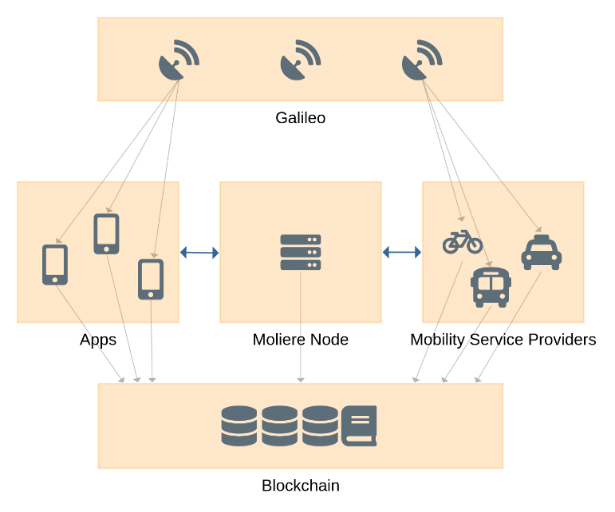After the great conversation we had with Iomob’s CEO, Boyd Cohen, Ph.D., where he explained the importance of the GALILEO satellite network behind Molière, he is now back with us to share how the Blockchain technology being developed by Iomob will enable Molière to become a tangible reality.
Dr. Cohen, welcome back! As you mentioned in our previous conversation, there is more to know about the role of Blockchain in Molière.
Dr. Cohen: Glad to be here again! Whilst last time we discussed the importance of geolocation in the new mobility paradigm and its role to enable the creation of a reliable Mobility Data Marketplace (MDM), we didn’t have time to expand on how Molière’s outcomes will be underpinned by Blockchain technology!
Could you tell us how Blockchain technology serves Molière’s MDM, and how it was determined to be the best solution to enhance mobility services?
Dr. Cohen: Considering that the collection of accurate geo-location data is a key requirement of modern mobility services, Molière also considers how the data is stored, distributed and used in order to provide a complete solution to the current issues the mobility market is facing. At the moment, the status quo of mobility data collection is that each service collects data on its vehicles, and stores it in its own isolated computer infrastructure. This leads to fragmentation, in the sense that there is no common infrastructure to interoperate with such data and services.
To put an end to this issue, Molière enables the ecosystem to organize around a blockchain layer which, by definition, provides a neutral, common-ground infrastructure. This way, it facilitates data publication, enrichment or rectification, its selective distribution, and the establishment of protocols for data exchange and operations (such as booking reservations of mobility services). Consequently, the utility of the obtained data and the mobility services they impact on is maximised. This will also facilitate integrated mobility experiences and will, in the scope of Molière, be demonstrated via a MaaS-type application.

Speaking about the MaaS-type app, Iomob performed a demo of the functionalities of the platform at the end of 2021 which allowed us to have a more detailed view of Molière’s MDM. Can you share more details of the MaaS platform?
Dr. Cohen: The app we are developing integrates various forms of transport services into a single mobility service accessible on demand. This enables users to discover the availability of modes and providers in a selected area, to choose one close to where they are, and to select their final mode as available in a very precise location (e.g. by a given address and in a specific side of the road). The construction of such a MaaS-type app is greatly simplified with Molière’s blockchain layer: rather than building a mobility aggregator with a small sub-set of mobility providers, Molière´s app can interoperate with all the MSPs integrated in the marketplace and, as an open infrastructure, can service many apps (or other kinds of front-end applications) with a unified interface.
Whilst everything that you explained sounds very appealing to users, one may wonder why MSPs (especially private ones) may wish to enable interoperability if they are competitors, and also if their connection carries direct integration costs. Are there any methods to incentivise MSPs to actually connect to the Blockchain infrastructure?
Dr. Cohen: Well, loosely speaking, mobility networks are comprised of mobility services which operate in coopetition (the act of cooperation between competing companies) rather than competition. For example, scooters can provide first and last mile coverage for trips enabled by longer-distance rail. Nevertheless, as MSPs can have a different view, incentives are being created for them as well as for node operators and front-end applications. The main incentive is the awarding of governance tokens to those companies which actually connect to the network and participate in the delivery of quality mobility services. The network then periodically reviews the exchanged mobility services, and computes a reward for each involved party based on the number of mobility services provided, the value of the service, and other factors that the token holders may deem of importance.
Considering the nature of the network, decentralized as we understand it, will there be any kind of rules to avoid “bad players” misreporting or pretending to deliver mobility services just to capture rewards?
Dr. Cohen: Indeed, as a consequence of these potential opportunities for fraud and deception, the network needs to verify which mobility services are being delivered in reality. Due to this, we are developing a mechanism to prototype and deploy our first approach to what we call proof of mobility service (PoMS) which requires every stakeholder to cryptographically sign the operations they perform and, most importantly, include a geo-location tag as appropriate. And, once again, geo-location from GALILEO is at the heart of this scheme – inaccurate, unreliable or insecure geolocation would be an unsuitable starting point to build and implement the PoMS approach.
Dr. Cohen, by what you are explaining, it seems like Iomob will have many interesting months ahead. Thanks for taking the time to speak to us, and we hope to hear from you again soon with exciting news!
Dr. Cohen: Thank you for your time, and I will keep you posted!



